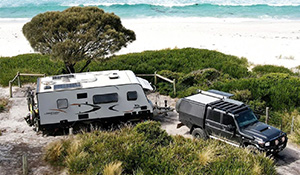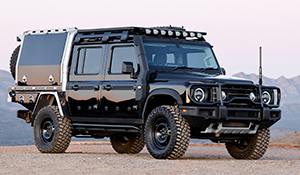Used Review: 2007-2016 Mitsubishi Pajero
Compared to its rivals the Mitsubsihi Pajero has been a quiet achiever for off-road and touring use, and it flies under the radar for many buyers looking for a capable used four-wheel drive. The current fourth-generation model is now 10-years old and early examples offer good value for money.
In terms of pricing, something with around 50,000km should be selling for less than $50,000 with a recent, good-looking 2012 model turbo-diesel we looked at listed for just $27,000. There are literally hundreds of 2014 models for sale online ranging in price from low $30s to early $40s. Go further back and you should be able to find a Pajero in the very early $20s.
When the Pajero arrived on the scene in early 1980s, Mitsubishi billed it as an alternative to the Toyota LandCruiser and to establish its off-road credibility and reliability story immediately entered it into the Dakar Rally where it won its class seven of the 10 times it was entered. It remains one of the most successful vehicles to have been raced at Dakar. There have been several generations since the first vehicle hit the market in the 1980s and we’re now on the fourth generation which was launched in 2006
The first two generations of the Pajero featured a body-on-chassis arrangement, which rode a little rough-and-tumble, until Mitsubishi introduced a monocoque (body integral to chassis) design for the third generation, which offers better on-road manners and three times the rigidity of previous models, according to Mitsubishi. The current fourth-generation is underpinned by the same monocoque design as its predecessor and essentially offers newer body styling, improved interior comfort and more safety features.

Both a three- and five-door wagon were available initially however sales of the three-door flunked and in 2010 the short-wheel base model was pulled. So most examples in the used market are the five-door model, which is a more practical option for families, towing, touring and off-roading.
Various models have been available in the Pajero line-up over the years, however, the main grades are GLX, GLS, VR-X and Exceed. The GLX offers a no frills entry point to the Pajero range but all models share the four-wheel drive system and similar exterior styling. The interior in the Pajero is its weakest point, but the GLS, VR-X and Exceed do offer leather seats and other luxury appointments as standard.
The interior layout features a good amount of storage options and there’s plenty of room for packing gear, but, because the third row pop-up seat isn’t split fold, it’s not possible to carry six passengers and a pram.

All but the entry-level GLX come standard with seven-seats and are available with either a 3.2-litre turbocharged diesel or 3.8-litre V6 petrol engine, with either a five-speed automatic or five-speed manual transmission. There’s about as many diesel models for sale as petrol in the used car market and both engines have proved reliable over the last decade as long as they’ve been regularly serviced. Regular servicing is particularly important on the diesel models and for diesel shoppers it’s prudent you check that the car has had its major 40,000km interval services.
If you’re looking for a car to tour and tow with, the diesel is the best option. Its higher torque output, 441Nm compared to 329Nm for the petrol, allows for a 3000kg towing capacity - 500kg more than the petrol. Although checking the towball download of the caravan you intend to tow, rather than just seeing the 3000kg capacity and shopping based on that will be a mistake, as the Pajero’s towball download is less than 200kg effectively bringing your towing choice down to 2000kg maximum. The diesel has better fuel economy, 11.3L/100km compared to the petrol’s 13.7L/100km, however it is noisier and there’s a decent amount of engine clatter in earlier models. If you’re not towing and won’t spend much time off-road, the petrol is worth a look.

As far as transmission options, the Pajero came with both, but there’s far more automatic equipped models for sale than manual. And while the manual provides a touch better economy, the five-speed automatic is a strong and reliable box and, apart from being easier to drive, it has manual shift functionality which works well for towing and off-roading.
For off-road work, the Pajero has always been capable and, although the monocoque body is a compromise of on-road manners and off-road ability, the Pajero will easily drive into and out of many rough or muddy tracks. All Pajero models feature a switchable centre differential lock and the VR-X and Exceed models come with a lockable rear differential as standard. The rear differential lock was also an option for GLX and GLS grade Pajeros, so it’s worth shopping around if you’re going to take it off-road.
In models fitted with a rear differential as standard there will be a switch for it on the lower centre console above the gearshift labelled ‘RD Lock’. It’s important to check the working order of all diff locks fitted to the vehicle and that they work without any vibrations or harshness – replacing these items can be expensive.

WHAT TO LOOK OUT FOR
We spoke with 4WD servicing expert Rob at The 4WD Work Shop in Seaford, Victoria, about what to look out for when buying a used Mitsubishi Pajero.
Petrol or Diesel?
Both are reliable and this choice comes down to personal preference and intended use – if touring, towing or off-roading then look for a diesel model. It is a little noisier to live with compared to the petrol but more grunt means it’s a more capable 4WD.
Try to find a model under 200,000kms, especially if looking at a petrol, and it’s important that the car has been regularly serviced for most of its life. It’s also imperative that the diesel has had every 40,000km major service interval completed.
There’s been reports of DPF (diesel particulate filter) failure in pre-2010 models which can lead to major engine failure, however, as long as the engine is regularly serviced there shouldn’t be any reason for concern. The Pajero diesels don’t like lots of short trips, so cars that have travelled some highway kilometres are also usually in better condition.
Rob has worked on diesel Pajeros that have completed over 600,000kms on the same engine, and as long as the oil is changed regularly there shouldn’t be any reason for concern about it.
TIP: It’s a good idea to install a micro fuel filter if one hasn’t already been fitted, a simple task and something the team at The 4WD Work Shop install regularly.

Driveline
Both transmissions are durable however the abundance of automatic models means it’s cheaper to replace a part if something goes wrong with one.
When taking the car for a test drive check for vibration or shuddering, particularly when taking off or at low-revs. Vibrations from the driveline can indicate the rear tail shaft slip joint is wearing and replacement of it should be considered in the final price.
Diesel models that have done about 80,000kms and older can develop a faint vibration from the engine when applying light throttle. It’s rare but some models exhibit the behaviour and it can be an indication the engine mounts are on their way out.
Electrical
The Pajero is pretty solid when it comes to electrical reliability, but sometimes the digital readout on the dash can start to glitch which will make reading it hard, especially during the day. The best bet to fix this is a visit to an auto electrician.
Off-road use
A lot of Pajeros will have been used off-road, which is what they’re made for, and they are pretty reliable out bush. However, be wary of any that have had a 2-inch lift kit installed as doing so makes the car prone to popping the rear tail shaft out which can cause damage to the driveline.
Inspect underneath the car and, if possible, put it on a hoist to have a proper inspection. Any serious wear will need to be attended to and if the car looks like it has been to Burke and back without being cleaned and maintained with care, rust and other issues could be hiding underneath. In fact the guys in the workshop have seen all extremes, including a leaking semi-porous differential housing that had been sandblasted on a trip around Australia, so make sure to take your time and if in doubt ask a 4WD professional to inspect the vehicle.
Alex Rae










